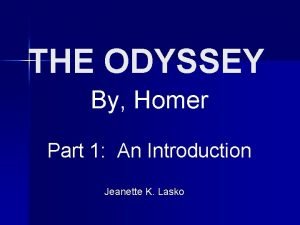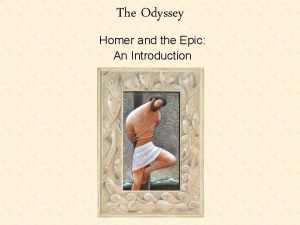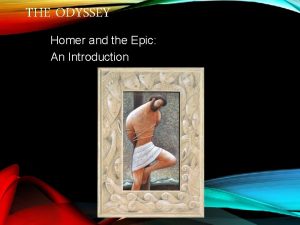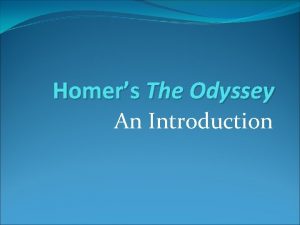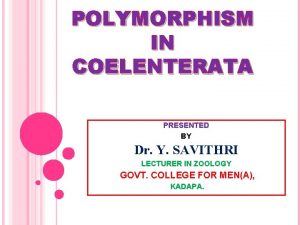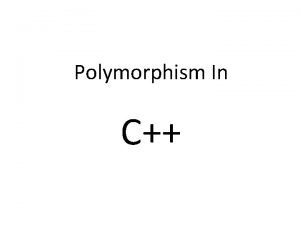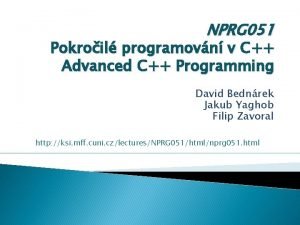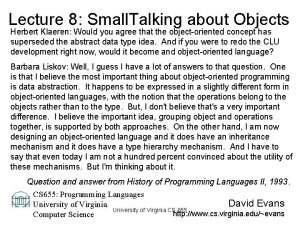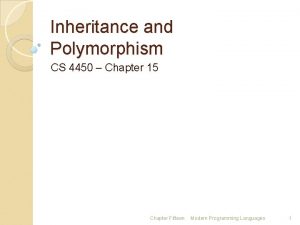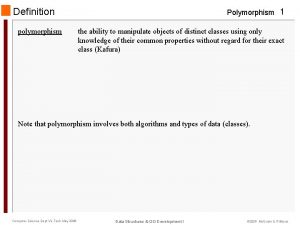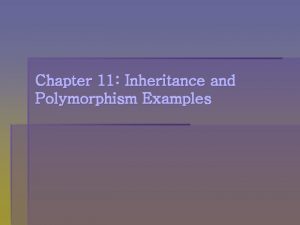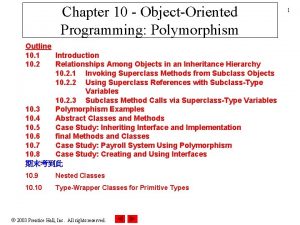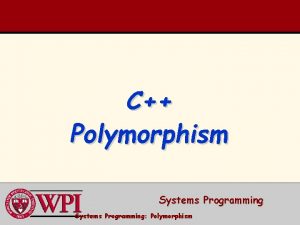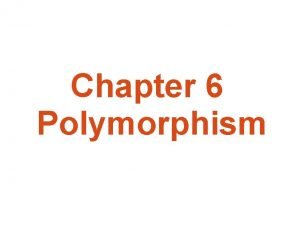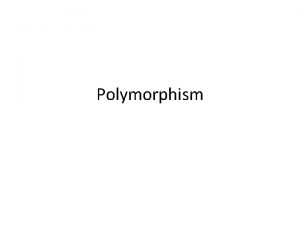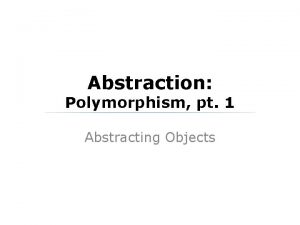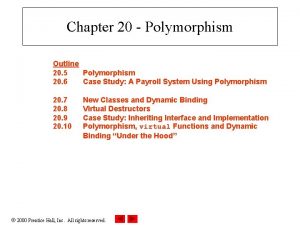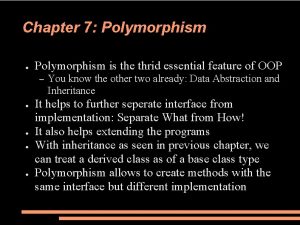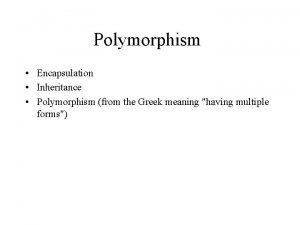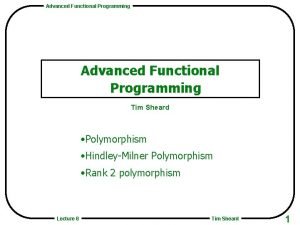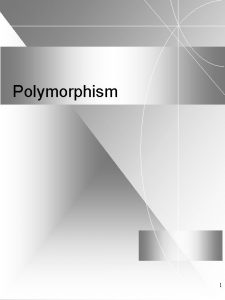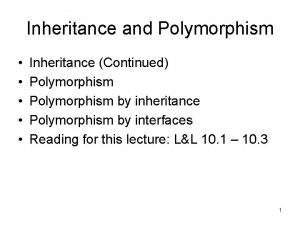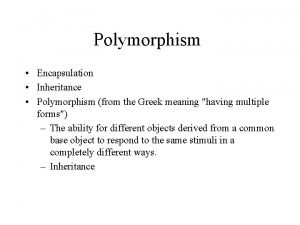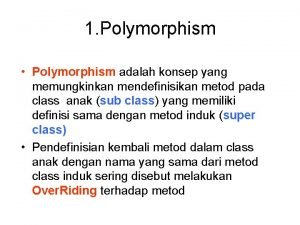Chapter 4 Polymorphism Part I Introduction to Polymorphism

































- Slides: 33

Chapter 4 Polymorphism Part I

Introduction to Polymorphism • There are three main programming mechanisms that constitute object-oriented programming (OOP) – Encapsulation – Inheritance – Polymorphism • Polymorphism is the ability to associate many meanings to one method name – It does this through a special mechanism known as late binding or dynamic binding © 2013 Pius Nyaanga. All rights reserved 8 -2

Introduction to Polymorphism • Inheritance allows a base class to be defined, and other classes derived from it – Code for the base class can then be used for its own objects, as well as objects of any derived classes • Polymorphism allows changes to be made to method definitions in the derived classes, and have those changes apply to the software written for the base class © 2013 Pius Nyaanga. All rights reserved 8 -3

Late Binding • The process of associating a method definition with a method invocation is called binding • If the method definition is associated with its invocation when the code is compiled, that is called early binding • If the method definition is associated with its invocation when the method is invoked (at run time), that is called late binding or dynamic binding © 2013 Pius Nyaanga. All rights reserved 8 -4

Late Binding • Java uses late binding for all methods (except private, final, and static methods) • Because of late binding, a method can be written in a base class to perform a task, even if portions of that task aren't yet defined • For an example, the relationship between a base class called Sale and its derived class Discount. Sale will be examined © 2013 Pius Nyaanga. All rights reserved 8 -5

The Sale and Discount. Sale Classes • The Sale class contains two instance variables – name: the name of an item (String) – price: the price of an item (double) • It contains three constructors – A no-argument constructor that sets name to "No name yet", and price to 0. 0 – A two-parameter constructor that takes in a String (for name) and a double (for price) – A copy constructor that takes in a Sale object as a parameter © 2013 Pius Nyaanga. All rights reserved 8 -6

The Sale and Discount. Sale Classes • The Sale class also has a set of accessors (get. Name, get. Price), mutators (set. Name, set. Price), overridden equals and to. String methods, and a static announcement method • The Sale class has a method bill, that determines the bill for a sale, which simply returns the price of the item • It has two methods, equal. Deals and less. Than, each of which compares two sale objects by comparing their bills and returns a boolean value © 2013 Pius Nyaanga. All rights reserved 8 -7

The Sale and Discount. Sale Classes • The Discount. Sale class inherits the instance variables and methods from the Sale class • In addition, it has its own instance variable, discount (a percent of the price), and its own suitable constructor methods, accessor method (get. Discount), mutator method (set. Discount), overriden to. String method, and static announcement method • The Discount. Sale class has its own bill method which computes the bill as a function of the discount and the price © 2013 Pius Nyaanga. All rights reserved 8 -8

The Sale and Discount. Sale Classes • The Sale class less. Than method – Note the bill() method invocations: public boolean less. Than (Sale other. Sale) { if (other. Sale == null) { System. out. println("Error: null object"); System. exit(0); } return (bill( ) < other. Sale. bill( )); } © 2013 Pius Nyaanga. All rights reserved 8 -9

The Sale and Discount. Sale Classes • The Sale class bill() method: public double bill( ) { return price; } • The Discount. Sale class bill() method: public double bill( ) { double fraction = discount/100; return (1 - fraction) * get. Price( ); } © 2013 Pius Nyaanga. All rights reserved 8 -10

The Sale and Discount. Sale Classes • Given the following in a program: . . . Sale simple = new sale("floor mat", 10. 00); Discount. Sale discount = new Discount. Sale("floor mat", 11. 00, 10); . . . if (discount. less. Than(simple)) System. out. println("$" + discount. bill() + " < " + "$" + simple. bill() + " because late-binding works!"); . . . – Output would be: $9. 90 < $10 because late-binding works! © 2013 Pius Nyaanga. All rights reserved 8 -11

The Sale and Discount. Sale Classes • In the previous example, the boolean expression in the if statement returns true • As the output indicates, when the less. Than method in the Sale class is executed, it knows which bill() method to invoke – The Discount. Sale class bill() method for discount, and the Sale class bill() method for simple • Note that when the Sale class was created and compiled, the Discount. Sale class and its bill() method did not yet exist – These results are made possible by late-binding © 2013 Pius Nyaanga. All rights reserved 8 -12

Pitfall: No Late Binding for Static Methods • When the decision of which definition of a method to use is made at compile time, that is called static binding – This decision is made based on the type of the variable naming the object • Java uses static, not late, binding with private, final, and static methods – In the case of private and final methods, late binding would serve no purpose – However, in the case of a static method invoked using a calling object, it does make a difference © 2013 Pius Nyaanga. All rights reserved 8 -13

Pitfall: No Late Binding for Static Methods • The Sale class announcement() method: public static void announcement( ) { System. out. println("Sale class"); } • The Discount. Sale class announcement() method: public static void announcement( ) { System. out. println("Discount. Sale class"); } © 2013 Pius Nyaanga. All rights reserved 8 -14

Pitfall: No Late Binding for Static Methods • In the previous example, the simple (Sale class) and discount (Discount. Class) objects were created • Given the following assignment: simple = discount; – Now the two variables point to the same object – In particular, a Sale class variable names a Discount. Class object © 2013 Pius Nyaanga. All rights reserved 8 -15

Pitfall: No Late Binding for Static Methods • Given the invocation: simple. announcement(); – The output is: Sale class • Note that here, announcement is a static method invoked by a calling object (instead of its class name) – Therefore the type of simple is determined by its variable name, not the object that it references © 2013 Pius Nyaanga. All rights reserved 8 -16

Pitfall: No Late Binding for Static Methods • There are other cases where a static method has a calling object in a more inconspicuous way • For example, a static method can be invoked within the definition of a nonstatic method, but without any explicit class name or calling object • In this case, the calling object is the implicit this © 2013 Pius Nyaanga. All rights reserved 8 -17

The final Modifier • A method marked final indicates that it cannot be overridden with a new definition in a derived class – If final, the compiler can use early binding with the method public final void some. Method() {. . . } • A class marked final indicates that it cannot be used as a base class from which to derive any other classes © 2013 Pius Nyaanga. All rights reserved 8 -18

Late Binding with to. String • If an appropriate to. String method is defined for a class, then an object of that class can be output using System. out. println Sale a. Sale = new Sale("tire gauge", 9. 95); System. out. println(a. Sale); – Output produced: tire gauge Price and total cost = $9. 95 • This works because of late binding © 2013 Pius Nyaanga. All rights reserved 8 -19

Late Binding with to. String • One definition of the method println takes a single argument of type Object: public void println(Object the. Object) { System. out. println(the. Object. to. String()); } – In turn, It invokes the version of println that takes a String argument • Note that the println method was defined before the Sale class existed • Yet, because of late binding, the to. String method from the Sale class is used, not the to. String from the Object class © 2013 Pius Nyaanga. All rights reserved 8 -20

An Object knows the Definitions of its Methods • The type of a class variable determines which method names can be used with the variable – However, the object named by the variable determines which definition with the same method name is used • A special case of this rule is as follows: – The type of a class parameter determines which method names can be used with the parameter – The argument determines which definition of the method name is used © 2013 Pius Nyaanga. All rights reserved 8 -21

Upcasting and Downcasting • Upcasting is when an object of a derived class is assigned to a variable of a base class (or any ancestor class) Sale sale. Variable; //Base class Discount. Sale discount. Variable = new Discount. Sale("paint", 15, 10); //Derived class sale. Variable = discount. Variable; //Upcasting System. out. println(sale. Variable. to. String()); • Because of late binding, to. String above uses the definition given in the Discount. Sale class © 2013 Pius Nyaanga. All rights reserved 8 -22

Upcasting and Downcasting • Downcasting is when a type cast is performed from a base class to a derived class (or from any ancestor class to any descendent class) – Downcasting has to be done very carefully – In many cases it doesn't make sense, or is illegal: discount. Variable = //will produce (Discount. Sale)sale. Variable; //run-time error discount. Variable = sale. Variable //will produce //compiler error – There are times, however, when downcasting is necessary, e. g. , inside the equals method for a class: Sale other. Sale = (Sale)other. Object; //downcasting © 2013 Pius Nyaanga. All rights reserved 8 -23

Pitfall: Downcasting • It is the responsibility of the programmer to use downcasting only in situations where it makes sense – The compiler does not check to see if downcasting is a reasonable thing to do • Using downcasting in a situation that does not make sense usually results in a run-time error © 2013 Pius Nyaanga. All rights reserved 8 -24

Tip: Checking to See if Downcasting is Legitimate • Downcasting to a specific type is only sensible if the object being cast is an instance of that type – This is exactly what the instanceof operator tests for: object instanceof Class. Name – It will return true if object is of type Class. Name – In particular, it will return true if object is an instance of any descendent class of Class. Name © 2013 Pius Nyaanga. All rights reserved 8 -25

A First Look at the clone Method • Every object inherits a method named clone from the class Object – The method clone has no parameters – It is supposed to return a deep copy of the calling object • However, the inherited version of the method was not designed to be used as is – Instead, each class is expected to override it with a more appropriate version © 2013 Pius Nyaanga. All rights reserved 8 -26

A First Look at the clone Method • The heading for the clone method defined in the Object class is as follows: protected Object clone() • The heading for a clone method that overrides the clone method in the Object class can differ somewhat from the heading above – A change to a more permissive access, such as from protected to public, is always allowed when overriding a method definition – Changing the return type from Object to the type of the class being cloned is allowed because every class is a descendent class of the class Object – This is an example of a covariant return type © 2013 Pius Nyaanga. All rights reserved 8 -27

A First Look at the clone Method • If a class has a copy constructor, the clone method for that class can use the copy constructor to create the copy returned by the clone method public Sale clone() { return new Sale(this); } and another example: public Discount. Sale clone() { return new Discount. Sale(this); } © 2013 Pius Nyaanga. All rights reserved 8 -28

Pitfall: Sometime the clone Method Return Type is Object • Prior to version 5. 0, Java did not allow covariant return types – There were no changes whatsoever allowed in the return type of an overridden method • Therefore, the clone method for all classes had Object as its return type – Since the return type of the clone method of the Object class was Object, the return type of the overriding clone method of any other class was Object also © 2013 Pius Nyaanga. All rights reserved 8 -29

Pitfall: Sometime the clone Method Return Type is Object • Prior to Java version 5. 0, the clone method for the Sale class would have looked like this: public Object clone() { return new Sale(this); } • Therefore, the result must always be type cast when using a clone method written for an older version of Java Sale copy = (Sale)original. clone(); © 2013 Pius Nyaanga. All rights reserved 8 -30

Pitfall: Sometime the clone Method Return Type is Object • It is still perfectly legal to use Object as the return type for a clone method, even with classes defined after Java version 5. 0 – When in doubt, it causes no harm to include the type cast – For example, the following is legal for the clone method of the Sale class: Sale copy = original. clone(); – However, adding the following type cast produces no problems: Sale copy = (Sale)original. clone(); © 2013 Pius Nyaanga. All rights reserved 8 -31

Pitfall: Limitations of Copy Constructors • Although the copy constructor and clone method for a class appear to do the same thing, there are cases where only a clone will work • For example, given a method badcopy in the class Sale that copies an array of sales – If this array of sales contains objects from a derived class of Sale(i. e. , Discount. Sale), then the copy will be a plain sale, not a true copy b[i] = new Sale(a[i]); //plain Sale object © 2013 Pius Nyaanga. All rights reserved 8 -32

Pitfall: Limitations of Copy Constructors • However, if the clone method is used instead of the copy constructor, then (because of late binding) a true copy is made, even from objects of a derived class (e. g. , Discount. Sale): b[i] = (a[i]. clone()); //Discount. Sale object – The reason this works is because the method clone has the same name in all classes, and polymorphism works with method names – The copy constructors named Sale and Discount. Sale have different names, and polymorphism doesn't work with methods of different names © 2013 Pius Nyaanga. All rights reserved 8 -33
 Part whole model subtraction
Part whole model subtraction Part to part ratio definition
Part to part ratio definition Brainpop ratios
Brainpop ratios Technical object description example
Technical object description example The centerpiece of any pouring station.
The centerpiece of any pouring station. The part of a shadow surrounding the darkest part
The part of a shadow surrounding the darkest part Minitab adalah
Minitab adalah The odyssey and epic poetry: an introduction, part 1
The odyssey and epic poetry: an introduction, part 1 Who is homer
Who is homer Epic poetry elements
Epic poetry elements Elizabethan theatre parts
Elizabethan theatre parts First part of introduction
First part of introduction The odyssey and epic poetry an introduction part 1
The odyssey and epic poetry an introduction part 1 Who was homer
Who was homer The odyssey and epic poetry an introduction part 1 quiz
The odyssey and epic poetry an introduction part 1 quiz An introduction to the odyssey
An introduction to the odyssey Hamlet, part 1: an introduction to elizabethan theater
Hamlet, part 1: an introduction to elizabethan theater Benvolio quotes act 1, scene 1
Benvolio quotes act 1, scene 1 The odyssey and epic poetry an introduction part 1
The odyssey and epic poetry an introduction part 1 Rcog mti
Rcog mti The odyssey and epic poetry an introduction part 1
The odyssey and epic poetry an introduction part 1 The odyssey and epic poetry an introduction part 1
The odyssey and epic poetry an introduction part 1 Physalia
Physalia What is polymorphism in c
What is polymorphism in c Ad hoc polymorphism
Ad hoc polymorphism What is polymorphism in oop
What is polymorphism in oop Compile time polymorphism in c++
Compile time polymorphism in c++ Subtype polymorphism
Subtype polymorphism Polymorphism computer science
Polymorphism computer science Cs 4450
Cs 4450 What is the difference between allotropy and polymorphism
What is the difference between allotropy and polymorphism Definition of polymorphism
Definition of polymorphism Polymorphism car example
Polymorphism car example Payroll system using polymorphism in java
Payroll system using polymorphism in java








